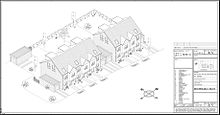Draftsman

Draftsmen create true-to-scale construction drawings and plans, formwork plans and reinforcement plans according to the specifications of an architect or engineer . They implement draft sketches and create standard-compliant construction and implementation drawings with floor plans , sections , views and details for approval procedures and for construction. Whereas in the past people used to draw with pencil and ink pen , today they are almost exclusively drawn on the screen with CAD (Computer Aided Design).
The profession of draftsman must not be confused with the profession of technical draftsman .
The professional profile and training differ fundamentally in different countries. In the following, the information is therefore listed separately by country.
The salaries of trained draftsmen differ significantly in terms of the focus / specialization chosen, whether they are employed by a company that is part of the construction industry (and its tariff affiliation), a free office or an authority, the professional experience and ultimately the skill of the Salary negotiations. There is no generally applicable collective agreement for draftsmen (in Germany).
Germany
Draftsman - civil engineering
job profile
The draftsman-engineering works independently on the basis of the planning of architects and specialist companies, the written static calculation and with the help of the corresponding DIN and EU standards, construction rules, approvals and installation regulations, according to which on the construction site or in the precast plant components and entire structures can be erected or manufactured. These construction drawings are called formwork plans, reinforcement plans and position plans. The shell construction of a building or component is simplified in formwork plans, the required steel reinforcement in a reinforced concrete component in reinforcement plans and the items listed in the written static calculation are shown with the corresponding number in position plans. These plans are further differentiated, for example, into plant plans and detailed plans. In addition, draftsmen and civil engineers produce calculations and documents accompanying the plans. The draftsman civil engineering work in engineering offices and planning departments of construction companies and precast factories. The draftsman engineering usually works exclusively on a CAD (Computer Aided Design) workstation with specialized CAD and statics software. The tasks of the draftsman-civil engineering are quite diverse, but also depend on the specialty within the engineering office. In detail, that would be: solid construction, prefabricated construction, timber construction, steel construction and special civil engineering.
conditions
This apprenticeship requires the following personal characteristics:
- Talent in the preparation of technical documents and drawing
- Reliable and precise work
- Spatial imagination
- Ability to work in a team / independent work / ability to communicate
- Mathematical and physical understanding
- Understanding of technology
This apprenticeship requires the following previous training:
- A successful secondary school leaving certificate
- or an equivalent level of education
Training as a draftsman - civil engineering
The training according to the Vocational Training Act takes place in the dual system in the company and in the vocational school . The regular training period is three years. The trial period lasts a maximum of four months. In the first year of the apprenticeship, the basics are taught, in the second year of the apprenticeship even more specialist knowledge is added to the fundamentals, and in the third year of apprenticeship the main focus is on repeating, deepening and consolidating. An intermediate examination takes place before the end of the second year of training.
The exact amount of the remuneration depends on whether the respective company acts in accordance with collective bargaining agreements or not. In the case of companies not bound by collective bargaining agreements, according to the Vocational Training Act, appropriate training remuneration must be paid. On average, this is around € 546 in the first year, € 678 in the second and € 810 in the third year of training in Germany.
further education
Under certain circumstances (e.g. several years of professional experience), the following further training opportunities are available:
- Civil engineer
- Trainer (responsible for training apprentices)
- Technicians in civil engineering or surveying technology
If a technical college has been successfully completed, it is possible to study at a technical college (FH), for example in the courses of civil engineering or architecture .
Draftsman - architecture (building construction)
job profile
The draftsmen are mainly trained in the planning and execution of architectural structures. You work in architecture firms. The draftsman usually works with CAD (Computer Aided Design) or, what is rarely found outside of vocational training today, at the drafting table. Since August 1, 2003, the specialty draftsman - building construction including space-creating expansion has been the new specialty draftsman - architecture . The training regulation for this profession has been changed.
conditions
This apprenticeship requires the following personal characteristics:
- Talent in technical drawing and free-hand drawing
- Reliable and accurate work
- Spatial imagination
- Teamwork / communication skills
- A sense of shapes and contrasts
This apprenticeship requires the following previous training:
- A successful secondary school leaving certificate
- or an equivalent level of education
Training as a draftsman - architecture
The training according to the Vocational Training Act takes place in the dual system in the company and in the vocational school . The regular training period is three years. The trial period lasts a maximum of three months. In the first year of the apprenticeship, the basics are taught, in the second year of the apprenticeship even more specialist knowledge is added to the fundamentals, and in the third year of apprenticeship the focus is on repeating, deepening and consolidating. An intermediate examination takes place before the end of the second year of training.
further education
Under certain circumstances (e.g. several years of professional experience), the following further training opportunities are available:
- Technical illustrator
- Trainer (responsible for training apprentices)
- Technicians in civil engineering or surveying technology
- Technician for business administration
If a technical college has been successfully completed, it is possible to study at a technical college (FH), for example in the courses of civil engineering or architecture .
Draftsman - civil engineering
job profile
The draftsmen - civil engineering are mainly trained in the planning and execution of civil engineering , road construction and landscaping . They work in companies in the construction industry and in engineering offices (focus on civil engineering / hydraulic engineering / traffic engineering and traffic engineering or gardening and landscaping).
conditions
This apprenticeship requires the following personal characteristics:
- Talent in technical drawing and free-hand drawing
- Reliable and accurate work
- Spatial imagination
- Teamwork / communication skills
- Enjoyment of structural connections
This apprenticeship requires the following previous training:
- A successful secondary school leaving certificate,
- or an equivalent level of education
Training draftsman - civil engineering
The training according to the Vocational Training Act takes place in the dual system in the company and in the vocational school. The training lasts three years. The trial period lasts a minimum of one month and a maximum of four months.
further education
Under certain circumstances (e.g. several years of professional experience), the following further training opportunities are available:
- Instructor (responsible for training apprentices.)
- Technicians in civil engineering or surveying technology
- Technician for business administration
If you have successfully completed a technical college, you can study at a technical college (FH):
- Graduate engineer (civil engineering, focus on civil engineering and hydraulic engineering, transport engineering).
Switzerland
In Switzerland, the training is more detailed than in Germany, which is why it takes longer, among other things. Structural draftsmen as well as draftsmen work very independently and bear great responsibility.
Structural draftsman
Now draftsman EFZ specializing in architecture
job profile
The structural draftsman is a technical employee of architects and site managers in the structural engineering planning sector. Building construction is the branch of civil engineering that deals with the planning and construction of structures that lie on and above the surface. (e.g .: buildings such as apartment buildings or towers). Structural draftsmen can be found in practically all large architectural offices. The structural draftsman supports the architect in the preparation of planning documents such as building applications , work plans and detailed plans .
He converts the architect's sketches into technical plans and helps the architect to solve design and technical problems.
He is jointly responsible for the communication between the office, the authorities and clients - mainly when it comes to technical and drawing problems. In general, the tasks of the structural draftsman also include the everyday office work and filling out construction forms, etc. The structural draftsman works with CAD (Computer Aided Design). Most of the time, people only work at the drawing table during apprenticeship training.
In addition, the structural draftsman must also produce small, simply built models (test and experimental models ) via a project, which z. B. offers the client an insight into the project. These models are not to be confused with presentation models. As a structural draftsman you work in architecture offices, in planning offices, in a planning department of a general contractor, or in building authorities and building administrations.
conditions
This apprenticeship requires the following personal characteristics:
- Talent in technical drawing and freehand drawing
- Enjoyment of structural connections
- Interest in the building trade
- Accurate and careful work
- Good observation and comprehension
- Mental agility
- Commitment and perseverance
- reliability
- independence
- Team and communication skills
- Environmental awareness
- Good spatial awareness and logical thinking
- Sense of shapes and colors
This apprenticeship requires the following previous training:
- Good grades in drawing , mathematics , physics and possibly chemistry
- Good reading and expressive skills (as the structural draftsman also has to write a lot, e.g. offers , construction documentation, etc.)
- Secondary school qualification (upper level qualification with extended requirements)
Training as a structural draftsman
The apprenticeship as a structural draftsman lasts four years. At the same time the vocational school (BMS) can be attended. The apprenticeship takes place in parallel in the company and in the vocational school . The learners spend one to one and a half days at school every week. Interval lessons are also practiced in different cantons. In this system, the first year the apprentice has four weeks of school to learn the most important basics. After this large block, the apprentice works for several weeks. During the remaining apprenticeship period, the apprentice has two weeks of school at irregular intervals.
Every year there is a so - called inter - company course (ÜK) throughout Switzerland . This course is compulsory for all learners. In these courses, the trainees are given tasks that need to be solved, further specialist knowledge is imparted and the learners are compared. In this way, it can be recognized relatively early whether a student needs additional help. These courses are paid for by the companies.
The vocational school provides the learners with general and vocational school education. The achievements in the subjects of construction engineering (building materials science - construction theory), drawing (projection drawing, shadow construction, perspective theory, freehand drawing), natural science basics (mathematics, building chemistry and building physics) and general education, abu ABU, (politics and economics, communication and society) are semester by semester graded. In addition to subject teaching and general education, there is also physical education, which is not graded.
The vocational baccalaureate lessons can be started in the first year of training and as a structural draftsman it lasts seven semesters. Anyone aiming for the vocational school leaving certificate must be prepared to put in above-average commitment in the company and in the vocational school. The BMS is therefore only suitable for learners with school qualifications that are higher than secondary school education (e.g. district school) or with an entrance examination from secondary school education. Since the final examination of the vocational baccalaureate subjects used to have to be passed almost simultaneously with the final apprenticeship examination, the 7 semesters were introduced so that BMS subjects can be completed from the third to the final seventh semester. This solution enables better learning planning for the final apprenticeship examination without additional stress. The vocational baccalaureate can also be completed after the apprenticeship (one year full-time training / two years part-time). If you pass the vocational school-leaving exam, you have the opportunity to go to the university of applied sciences without exams .
The final apprenticeship examination (LAP) takes place shortly before the end of the apprenticeship. There the learner should show whether he has achieved the learning goals set out in the education ordinance and in the school curriculum. In the final apprenticeship examination, you can use the workbook (which is also assessed) and all other permitted aids (depending on the canton). The exam takes place in the school and in your own office. The instructor in the company must undertake that he will not help the apprentice under any circumstances, otherwise he can be severely punished. The examination is passed if neither the subject grade and the “practical work” nor the overall grade falls below 4.0. For the assessment, the experience grade (overall average of all previous certificate grades) and the grade of a self-immersion work (SVA) in connection with the general education grade are taken into account. Apprenticeship final exam candidates who have attended the BMS cannot benefit from this grade because they have not completed any general education or SVA.
further education
Structural draftsmen have many opportunities to specialize and further educate themselves. To name a few:
- Vocational high school diploma, one year full-time training or two years part-time
- Additional craft apprenticeship: bricklayer , carpenter , joiner, etc. a. m.
- Site manager / site manager / foreman
- Architect, now also Bachelor of Science and Master of Science
- Interior architect , industrial designer FH, landscape architect , etc. a. m.
There are various other further training options. Since great changes are currently taking place in the area of further training, training opportunities and admission requirements must be constantly re-examined.
Draftsman
Now draftsman specializing in civil engineering
job profile
The draftsman is a technical employee of the civil engineer . He converts sketches and calculations by civil engineers into true-to-scale plans. Draftsmen are trained in the planning and execution of civil engineering structures , civil engineering , road construction , tunnel construction , bridge construction and also hydraulic structures such as hydroelectric power stations , dams and sewage treatment plants . Engineering structures refer to supporting structures made of steel , reinforced concrete and wood . The draftsman works with CAD (Computer Aided Design). The work at the drawing table has almost completely disappeared, and the students also work on the computer with CAD from the first year of their apprenticeship. Draftsmen also go to the construction sites and participate in construction inspections. In doing so, they check that the plans match the structure and check the reinforcement. From time to time draftsmen make measurements. Administrative work is also part of everyday life. Draftsmen work in private engineering offices, in a project planning department of a construction company, in a construction company or in public building and planning offices.
conditions
This apprenticeship requires the following personal characteristics:
- Mathematical and technical knowledge
- Good spatial awareness and logical thinking
- Team and communication skills
- Talent in drawing and freehand drawing
- Enjoyment of structural connections
- independence
- Accurate and careful work
This apprenticeship requires the following previous training:
- Secondary school qualification (upper level qualification with extended requirements)
- Good grades in: geometry, algebra, arithmetic and technical drawing
Training as a draftsman
The regular training period lasts four years. At the same time the vocational school (BMS) can be completed. The apprenticeship takes place in parallel in the company and in the vocational school. In the first year of their apprenticeship, the apprentices spend at least one to two days a week in school. In the second, third and fourth year of training, there are sometimes also block school weeks, depending on the canton in which the training is being completed. Interval lessons are also practiced in certain cantons. School time is the same as if the apprentice had school once a week.
Every year there is a so-called inter-company course (ÜK) throughout Switzerland. This course is compulsory for all learners. In these courses, the trainees are given tasks that need to be solved, further specialist knowledge is imparted and the learners are compared. In this way, it can be recognized relatively early whether a student needs additional help. These courses are paid for by the companies.
The vocational school provides the learners with general and vocational school education. The achievements in the subjects of construction engineering (building materials science - construction theory), drawing (projection drawing, shadow construction, perspective theory, freehand drawing), natural science basics (mathematics, building chemistry and building physics) and general education, abu ABU, (politics and economics, communication and society) are semester by semester graded. In addition to subject teaching and general education, there is also physical education, which is not graded.
The LAP takes place shortly before the end of the apprenticeship. There the learner should show whether he has achieved the learning goals set out in the education ordinance and in the school curriculum. The exam is passed if neither the subject grade and the “practical work” nor the overall grade falls below 4.0.
Anyone aiming for the vocational school leaving certificate must be prepared to put in above-average commitment in the company and in the vocational school. The BMS is therefore only suitable for learners with school qualifications that are higher than secondary school education (e.g. district school) or with an entrance examination from secondary school education. The vocational baccalaureate can also be completed after the apprenticeship (1 year full-time training / 2 years part-time). If you pass the vocational school-leaving exam, you have the opportunity to go to the university of applied sciences without exams.
further education
As a draftsman you have several options for further training:
- Vocational high school diploma, one year full-time training or two years part-time
- Site manager / site manager / foreman
- Engineer FH civil engineering, engineer FH spatial planning
- Architect FH, architect ETH, now also Bachelor of Science and Master of Science
There are various other further training options. Since great changes are currently taking place in the area of further training, training opportunities and admission requirements must be constantly re-examined.
Austria
In Austria there is still no specialization in building construction / civil engineering, etc. for the apprenticeship construction draftsman . This can be acquired later in further training.
Structural draftsman
job profile
The job description is similar to that of the German and Swiss colleagues. Structural draftsmen design and use the CAD system to draw plans for civil engineering as well as for industrial plants or roads. In addition, they take on organizational and administrative tasks in the execution of the construction project. B. Protective measures to avoid personal injury and property damage. They are usually under the guidance of a construction technician and work in architectural and civil engineering offices and construction companies.
conditions
The prerequisite for the admission of the apprentice is the completion of a secondary school or polytechnic school. Personal skills and requirements:
- spatial imagination
- basic technical understanding
- Ability to concentrate
- systematic, planned way of working
education
In Austria, too, training takes place in the dual system in training companies and vocational schools. The apprenticeship period is three years and ends with the final apprenticeship examination.
further education
The further training opportunities are very extensive. Subject-specific training and courses are offered, related apprenticeships ( technical draftsman , surveying technician ) can usually be completed within 1 additional year of training. Possible higher qualifications:
- Foreman
- Qualifications from technical schools, colleges,
- Matura at higher vocational schools
- Construction technician (college, university)
See also
Individual evidence
- ↑ Apprenticeship draftsman azubify . In: azubify . ( azubify.de [accessed on January 22, 2018]).
- ↑ Training ordinance of the Austrian Ministry of Economics ( page no longer available , search in web archives ) Info: The link was automatically marked as defective. Please check the link according to the instructions and then remove this notice. (PDF file; 53 kB) valid since August 2007
- ↑ Education and training information from the Institute for Economic Research: BerufsInformationsComputer (BIC)
Web links
- Germany
- Professional profile draftsman
- IHK draftsman
- Framework plan for draftsman training (PDF file; 155 kB)
- Switzerland
- Austria
- Vocational and advanced training information from the Institute for Economic Research: Vocational Information Computer (BIC)
- Education regulations of the Ministry of Economic Affairs
- Amount of the collectively agreed apprenticeship remuneration
- Professional and industry information from the Austrian Chamber of Commerce













